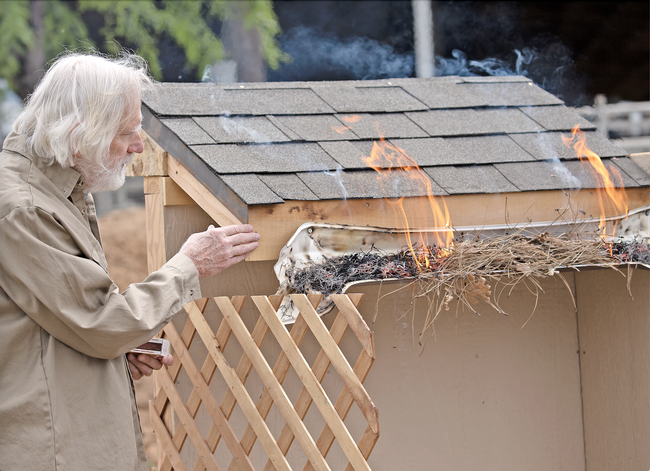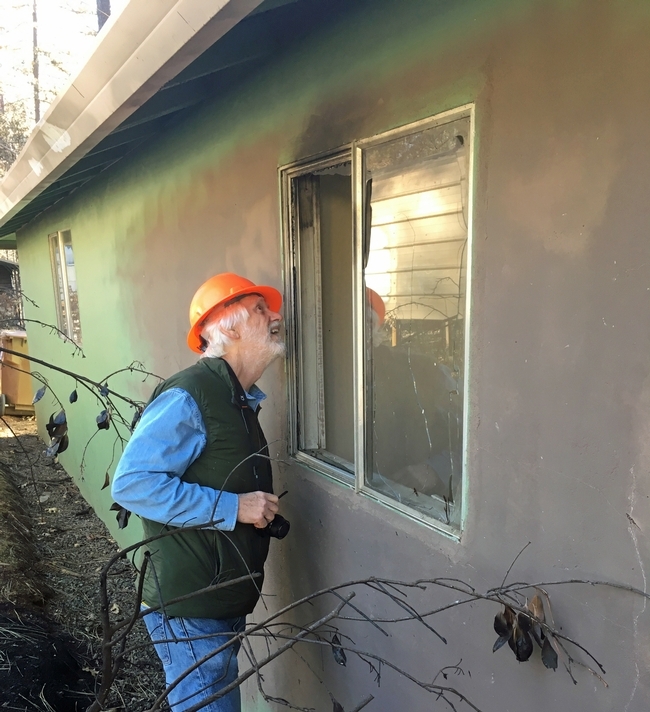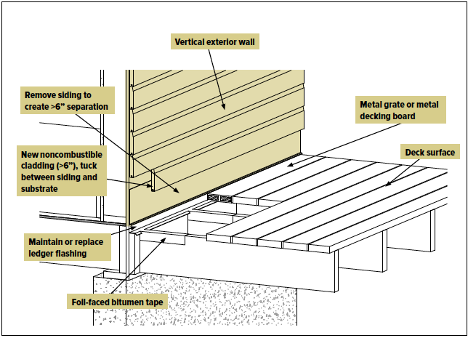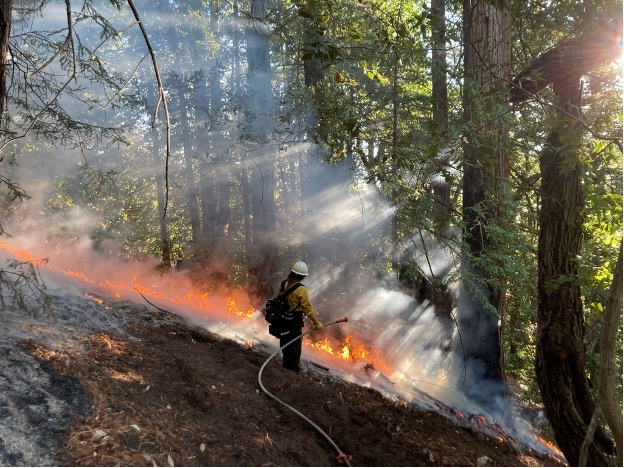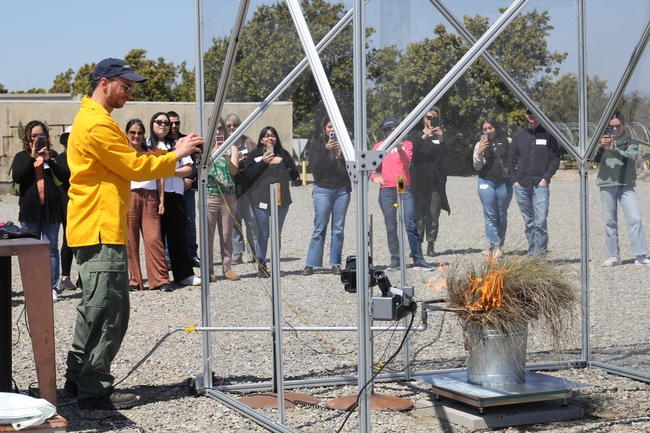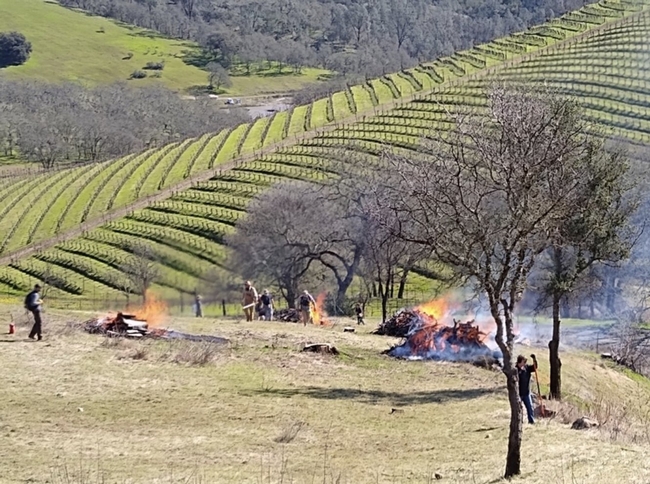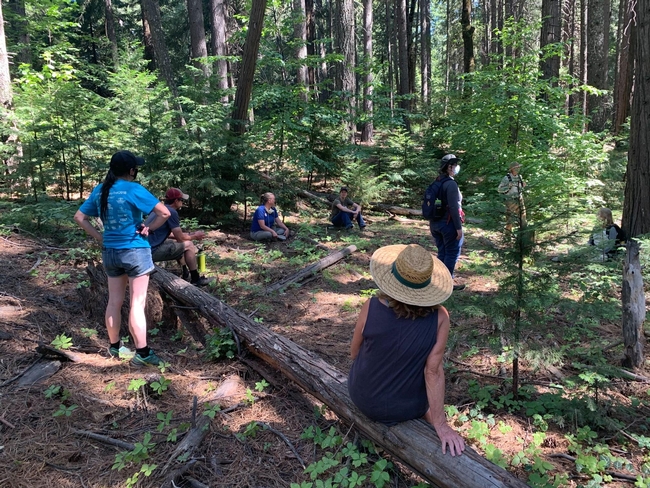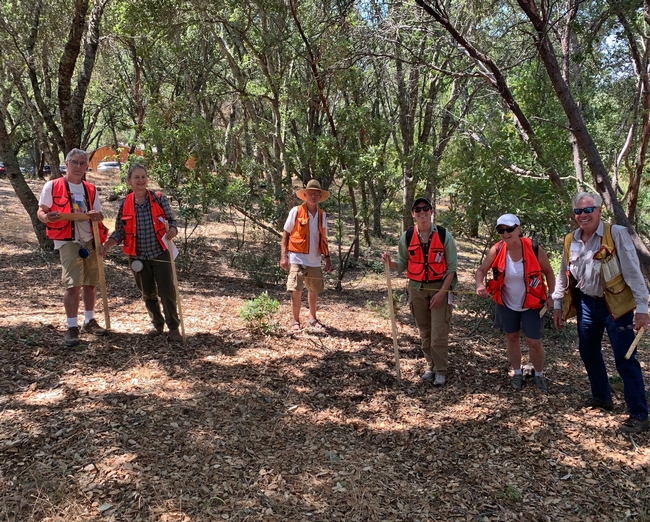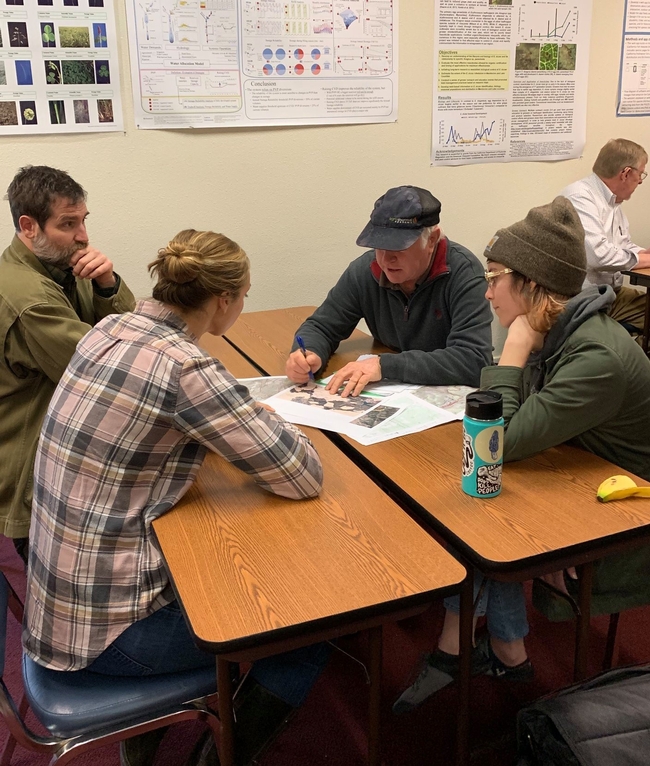Posts Tagged: Wildfire
Report: Making homes more resistant to wildfire can be affordable
Priorities include removing objects within five feet of a house, upgrading vents
Wildfire losses cost taxpayers and communities hundreds of billions of dollars each year, and preparing communities before a disaster occurs is the best way to avoid damage to homes and neighborhoods. Retrofitting existing homes can make communities safer while avoiding billions in disaster costs.
As Californians learn to live with wildfire, scientists encourage improving the structure and design of houses and other buildings to help them survive wildfire. A new report shows that even inexpensive changes can increase wildfire resistance.
“Retrofitting a Home for Wildfire Resistance” suggests that some of the most effective strategies to reduce the vulnerability of homes and neighborhoods to wildfire can be done affordably.
“This report is a practical tool that helps evaluate the relative costs and benefits of fire-hardening retrofits,” said Yana Valachovic, a University of California Cooperative Extension forest advisor, who reviewed the study. “These retrofits can substantially improve the odds that a home or building will withstand wildfire exposures to embers, radiant heat or flame contact.”
The report is co-authored by Kimiko Barrett, wildfire research and policy analyst for Headwaters Economics, a non-partisan research organization based in Bozeman, Montana, and Stephen L. Quarles, UC Cooperative Extension advisor emeritus, who has studied the vulnerability of the built environment to wildfire exposures and potential mitigation strategies.
In partnership with California's Department of Forestry and Fire Protection, or CAL FIRE, Barrett and Quarles examined the costs for improving the structure and design of existing homes to increase their wildfire resistance.
“This tool can also help homeowners build a budget and prioritize tasks that often feel overwhelming,” Valachovic said. “Everyone should prioritize removing combustible vegetation, mulch, and stored materials within the first five feet of a structure and upgrading vents to resist embers.”
Simple actions can reduce a home's vulnerability to wildfire
The report's conclusions are derived from a detailed examination of the latest available science on mitigation strategies and construction costs. The authors identified costs for retrofitting structures to meet and exceed California's building code (Chapter 7A) for wildfire resistance, but the general principles and conclusions can be applied in other states, adjusting for local economic and supply conditions.
For a typical 2,000-square-foot home in California, retrofitting costs can range from $2,000 to upwards of $100,000 for the highest level of protection.
“When we looked at the latest building techniques and cost data, we found some effective retrofitting strategies can be done for between $2,000 to $10,000,” said Barrett. “While the highest level of protection can cost more, it is often not necessary. Simple actions such as removing flammable materials from near the home and removing debris from the roof can be done at little to no cost.”
The authors also incorporated effective mitigation strategies that could reduce risk without requiring costly upgrades over the entire home, such as replacing siding only on the side of a home that is close to another building, such as neighbor's home or a detached garage, or replacing combustible deck boards next to the home with a noncombustible deck board or metal grate.
They also incorporated a systems approach, where the vulnerability of adjacent components are considered, and recommend steps such as placing noncombustible surfaces at the intersection between two components.
For example, Quarles said: “Adding a gutter cover and ensuring the adjacent edge of roof is not vulnerable by incorporating a metal drip edge and, if necessary, a noncombustible bird stop at the edge of the roof. Or, replacing a combustible deck board next to the house and, if necessary, adding metal flashing at the base of the exterior wall.”
Cost estimates in the report include those for upgrading a home's exterior walls, roof, deck, windows, doors, eaves, gutters and near-home landscaping – all areas likely to be exposed to embers, direct flames and radiant heat.
“The graphics detailing specific elements of the retrofitting process are very useful,” Valachovic said.
Charts, architectural renderings and a detailed appendix of cost estimates provide a basis for a general understanding of the methods and budgets that homeowners might consider when retrofitting their home for wildfire resistance.
Retrofitting for wildfire can make communities safer
Contractors and others seeking information about building wildfire-resistant homes can gain valuable insights from this analysis, along with retrofit costs generated by the California Wildfire Mitigation Program.
“This analysis demonstrates that investing in wildfire-resistant retrofitting for homes is a cost-effective strategy to protect communities that could save billions in disaster costs,” said Barrett. “As more people live in fire-prone areas, we must also take a closer look at retrofitting homes to be stronger and more durable.”
While the authors hope Californians use the information to protect their homes, people who work in construction, development, design and policy also can use the information to show that retrofitting homes for wildfire resistance is an effective way to protect communities.
This 58-page report received funding from CAL FIRE and the U.S. Forest Service and can be downloaded for free at https://headwaterseconomics.org/wp-content/uploads/2024/06/Wildfire_Retrofit_Report_20240624.pdf.
Public invited to observe prescribed fire training in Santa Cruz County
First Forester TREX to be held June 3-6
California's first-ever Forester Prescribed Fire Training Exchange event focused on bringing together professional foresters, forest managers and fire practitioners will occur June 3-6 near Watsonville. The four-day event is being hosted by the Central Coast Prescribed Burn Association, which empowers the public to build a culture of good fire and supports private landowners in conducting prescribed burns in Monterey, San Benito and Santa Cruz counties.
There will be one burn conducted during the event, likely on June 4 or 5, which will be open for the public to observe.
Prescribed Fire Training Exchanges (TREXs) first came to Northern California in 2013, and have made a positive cultural shift concerning prescribed fire, within both regional fire services and the general public. These “good fire” TREX events have drawn significant attention, especially in the context of more severe wildfire seasons.
After months of cross-organizational planning, the four-day long training will be focused on exploring the connections between sustainable forest management, wildfire resilience, timber harvesting, prescribed fire, and will include a burn within a commercially harvested redwood forest. The TREX will provide experiential training opportunities to forest managers and planners to advance statewide knowledge of how to conduct prescribed fire in merchantable timber stands.
Along with the prescribed burn, the program will include lectures, local tours, and open discussions on how to incorporate fire into timber management, burn planning and timber harvest planning, pre- and post-fire considerations, and permitting mechanisms for fire and timber harvesting. Presentations will be given by local forestry consultants, University of California Agriculture and Natural Resources, CALFIRE and local fire practitioners.
The burn location will occur near Mount Madonna, on private land with access allowed for accompanied observation only. Be advised, while the ForesterTREX planning team works closely with theMonterey Bay Air Resources District to assure good smoke dispersal, smoke may be seen and be present in these areas during and after a burn. Please see the Central Coast Prescribed Burn Association webpage at calpba.org/centralcoastpba for updates close to the burn date.
Participants and partners include the Mount Madonna Center, members of the Amah Mutsun Tribal Band and the Esselen Tribe of Monterey County, University of California Agriculture and Natural Resources, Resource Conservation District of Monterey County, CALFIRE, local land trusts, scientists, ranchers, students, researchers, land managers and others. The Central Coast Prescribed Burn Association is currently funded via California Coastal Conservancy grants.
For more information or to join a group of observers, contact Barb Satink Wolfson, UC Cooperative Extension area fire advisor at bsatink@ucanr.edu.
Latest research in fire science focus of free webinar series
Wildfire, cultural and prescribed burns, plant flammability among topics covered
Interested in learning about some of the latest research in fire science and stewardship? Join the UC ANR Fire Network for a series of free lunchtime webinars to explore fire science topics with colleagues from across the globe.
This four-part webinar series will address fire in land management, plant flammability, fire history and management and forestry and fuel profiles.
Everyone is welcome to watch the Hot Topics in Fire Science and Stewardship Webinar Series.
Restoring Fire to Meadows and Other Cultural Landscapes
Presenters: Alice Lincoln-Cook, California Indian Basketweavers Association; Brian Peterson, Fire Forward
- May 29, noon–12:45 p.m. Pacific Time
- Register by May 29: https://bit.ly/3Qksc0J
How Can We Assess Plant Flammability?
Presenters: Jane Cawson, University of Melbourne; Max Moritz, UC Santa Barbara and UC ANR
- June 5, 3–3:45 p.m. Pacific Time
- Register by June 4: https://bit.ly/3WetrlA
Nuances in Fire History and Management: Lessons from Oregon Presenters: Andrew Merschel, U.S. Forest Service Pacific Northwest; Chris Dunn, Oregon State University
- June 12, noon–12:45 p.m. Pacific Time
- Register by June 11: https://bit.ly/44fMU7u
Forestry and Fuel Profiles
Presenters: Don Radcliffe, University of Washington; Eric Knapp, U.S. Forest Service Pacific Southwest
- July 17, noon–12:45 p.m. Pacific Time
- Register by July 16: https://bit.ly/4aTqI5Q
For more information, visit https://ucanr.edu/sites/fire/Home_430/Events.
Wildfire preparedness strategies for farms covered in UC ANR webinars
UCCE advisors will present webinars on May 21 and 28
Late spring rains have delayed California's fire season this year, which provides farmers and ranchers an opportunity to improve their wildfire preparedness. Barns, wood fencing, hay and other property commonly found on farms have inherent vulnerabilities to wildfire.
Fortunately, buildings and infrastructure can be hardened and maintained to reduce their vulnerability to fire and fire-related damage to agricultural resources. Having a plan in place to keep livestock safe and healthy is essential to maintaining animal health and resume operations as quickly as possible post-wildfire. Join the UC Agriculture and Natural Resources Fire Network team to learn about wildfire preparedness strategies for farms and ranches.
The two-part webinar series will cover hardening structures and managing livestock during wildfire.
Part 1: Ranch Hardening and Wildfire Preparedness Strategies for Agricultural Structures
- May 21 at 6-7 p.m.
- Join UC Cooperative Extension fire advisor Luca Carmignani and UCCE forest advisor Yana Valachovic to discuss best practices for incorporating principles of structure hardening and defensible space into agricultural structures and operations.
- Register by May 20 at https://bit.ly/3y1MbuP. Link to webinar will be emailed to registrants.
Part 2: The Realities of Managing Livestock Health During Wildfire
- May 28 at 6-7:30 p.m.
- Join UCCE livestock and natural resource advisors and our partners for a set of presentations about managing livestock health during wildfire events and what to do if you find yourself trapped by an approaching wildfire.
- Register by May 20 at https://bit.ly/3y1MbuP. Link to webinar will be emailed to registrants.
Connecting California’s forest landowners with California Tree School
While trees and forests are often emblematic of constancy in a fast-paced world, our state's forests are actually changing before our eyes. Since 2020, the UC ANR Forest Stewardship Education (FSE) program has been helping California's forest landowners be proactive about the inevitable shifts their forestland will experience. The Forest Stewardship and Post-Fire Forest Resilience workshop programs use an online educational format, which guide landowners through the basics of creating forest management plans and managing post-fire landscapes, respectively. Now, the FSE team is piloting a new program to engage a wider audience of forest landowners and community members passionate about trees.
This spring, the Forest Stewardship and UC ANR Fire Network teams are holding the first California Tree School, where individuals attend multiple in-person classes on the forestry topics they are most curious about. “The existing online programs are very focused on forest management plans and post-fire activity, and [Tree School] lets us tackle other topics,” said UC ANR forest and natural resources advisor Susie Kocher.
A one-stop shop for continuing forestry education
California Tree School was inspired when Forest Stewardship Academic Coordinator Kim Ingram, Post-fire Academic Coordinator Katie Reidy and Kocher attended Oregon State University Extension's Tree School event in Clackamas County, Oregon. OSU Tree School is a day-long experience comprised of classes that cover the different dimensions of forestry: constructing a house from your own timber, carbon cap and trade, and buying portable sawmills are just a small sampling of the options for attendees. OSU Tree School students ranged from forest landowners to community college students, contributing to a space which would facilitate community connections as well as learning.
Kocher described the experience as a “a great one-day, one-stop shop to keep up-to-date on what we [forest landowners and professionals] should know.” Excited by the breadth of opportunities offered at OSU's Tree School, Ingram, Kocher and Reidy were inspired to bring the format to California.
“It's our time to discuss the whole ecosystem,” noted Reidy. “Tree School is bringing in the trustworthy, reliable group of experts who can provide more information on the questions pertaining to landowners' specific goals.”
California Tree School will be offered in two locations this spring, with CA Tree School- Hopland taking place on May 4, and CA Tree School- El Dorado on June 1. Similar to OSU's Tree School, attendees are expected to be a mix of forest landowners, natural resource professionals and interested community members.
Connecting statewide professionals; personalizing forestry education
Tree School offers attendees the opportunity to focus on subjects that pertain to their specific learning needs. This personalized approach is a new foray for the Forest Stewardship team, but is something that Ingram says workshop participants have been wanting for some time.
“Our participants never think they learn enough. They are always asking for more information, and this Tree School gives us the chance to expand on things we might not have had a chance to go over in the workshop series,” remarked Ingram. Additionally, Tree School instructors had creative freedom when it came to developing their classes, from the topic to the class format. This is evident when browsing through each session's class catalog. CA Tree School attendees choose four classes to attend, meaning they can build their first burn pile, understand the ins and outs of regional wildlife, paint outdoors and learn how to aid statewide reforestation efforts all in one day.
“I felt that Tree School created a sense of trust around complex topics,” noted Reidy about her experience last year in Oregon. For CA Tree School, the Forest Stewardship team aims to do the same. This meant recruiting from throughout the UC ANR network and other organizations, including CALFIRE and CARCD (California Association of Resource Conservation Districts), to bring trusted voices to the community.
“What's exciting about Tree School is that we are bringing natural resource professionals from all around to engage everyone at the same time, and all in one place,” noted Ingram.
The team is excited to see all the connections that will be made between community members and professionals during this pilot year, and “if this is successful and we can bring it back next year,” commented Kocher, “we are definitely interested in partnering with more people and expanding our outreach.”
Making CA Tree School an in-person experience was important to the team, as much of the education is hands-on. Additionally, Kocher sees enhanced potential for building personal connections: “In person, you have this opportunity for people to identify as part of a community,” noted Kocher, “So I'm excited for people to hang out with each other.”
Encouraging an informed community
“You can't separate the emotional from the physical, and there are a lot of topics in forestry like wildfire and economics that can be a bit of a downer,” said Ingram. “I'm excited to help create a positive learning environment, and one that encourages folks to turn to UC Cooperative Extension for these resources.”
“Our main goal here is to get science out there,” concurred Reidy. “The more exposure people have to science, the more confident they feel in themselves and their wants and needs.”


